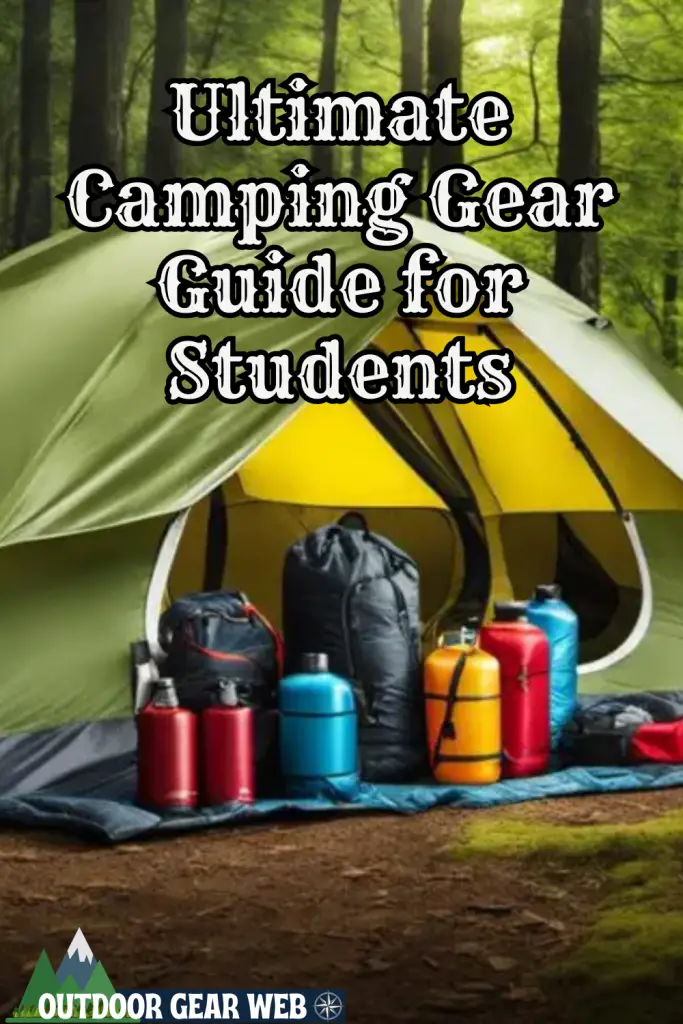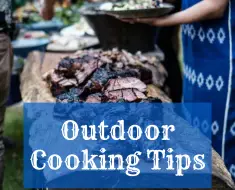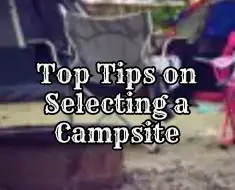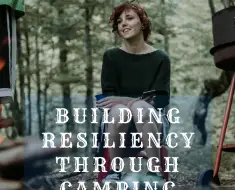
Embracing the wilderness for a camping trip is one of those memorable hobbies that stay with students for life. It’s a never-ending journey into the heart of nature, offering a beautiful blend of learning, thrill, relaxation, and pure joy. However, alongside the excitement, it is essential to be equipped with the necessary camping gear to ensure a safe and enjoyable experience. This ultimate camping gear guide for students thoroughly enlists and explains the vital camping essentials. It is tailored to meet their unique requirements. It ranges from basic necessities, appropriate clothing, and footwear, to food, cooking equipment, safety precautions, and tech-based entertainment necessities. Each section has been crafted to consider different scenarios and camping conditions students might face.
If it is their first time winter camping check out these tips before you head out!
Ultimate Camping Gear Guide for Students: Basic Necessities
Essential Camping Gear: Tents
One of the key items in any camping gear setup is the tent. This is your home away from home and it’s crucial to have something that properly fits your needs. Tents come in a range of sizes, from one-person tents to larger family-sized ones. Note that a “two-person” tent typically means there is enough sleeping room for two people, with minimal additional space. So if you’re camping with a friend and need room for your backpacks and kits, you should consider going one size up.
When choosing a tent, consider what sort of conditions you’ll be camping in. If you’re camping in the summer, look for a tent with lots of mesh and ventilation to keep cool. But if you’ll be camping in colder, windier conditions, look for a tent with fewer mesh panels to keep the cold air out.
The Importance of the Right Sleeping Bag
Your sleeping system is another vital part of your camping gear. When looking at sleeping bags, check out the temperature rating. This tells you up to what temperature the sleeping bag will keep you warm. If you’re heading for a summer trip, you won’t need a sub-zero-rated bag. However, if you’re planning a winter adventure, you’ll want something more substantial.
Remember, you can always unzip a sleeping bag if you’re too hot but trying to sleep when you’re freezing cold is much more challenging. Hence, it’s better to err on the side of caution. So choose a sleeping bag with a lower temperature rating if you’re uncertain.
Check out this detailed guide on sleeping bags to find the right one for your student’s trip.
Backpack Basics
Your backpack will likely be carrying all your essentials. This is why it is included in our ultimate camping gear guide for students. So, it’s important to choose one that’s comfortable and suitable for your needs. Look for a backpack that has multiple compartments for easy access to your items. Adjustable straps and a good hip belt can also make a world of difference when you’re on the trail. Make sure your backpack is large enough to fit all your gear, but not so large that it’s unwieldy or uncomfortable.
Stay Hydrated with a Water Bottle
No camper should leave home without a good, durable water bottle. Shatter-proof and leak-proof are the keys when picking a bottle. Also, consider size and whether you’d like it to have a built-in filter. Some people also prefer bottles with a wide mouth for easier cleaning and filling. Don’t want to go with a water bottle? Use a bladder in your backpack. These options make carrying and drinking water while hiking a breeze.
The Mighty Flashlight
There are various types of flashlights available like LED flashlights, headlamps, and lanterns. Think about what you’ll be using your flashlight for. If you need to keep your hands free, a headlamp might be the best choice. If you want to illuminate a larger area, a lantern might be a good choice. Regardless, make sure whatever you choose is waterproof, sturdy, and preferably features adjustable brightness.
Embarking on a camping adventure as a student presents a unique opportunity to gain hands-on experiences about self-reliability, appreciation of the environment, and mastering several essential survival skills. However, to fully immerse oneself in this enriching experience, the first step is to properly equip oneself using these and the rest of the items on this ultimate camping gear guide for students. Thereby, eliminating worries about shelter, warmth, loading essentials, hydration, or navigating in the dark. The crux of the matter lies in making informed choices about the camping tools you need.

Take your students out to one of these National Parks
Ultimate Camping Gear Guide for Students: Clothing and Footwear
Choosing the Right Clothing for Your Camping Expedition
In the realm of camping, clothing that is tailored to the prevailing weather conditions remains an indispensable aspect. If you’re planning a summer camping trip, make sure to opt for clothes that are both lightweight and light-colored, as these features will help you to reflect rather than absorb the sun’s heat. Opting for fast-drying fabrics such as polyester or nylon can reap dividends as they will wick away sweat, keeping you dry and comfortable in the process. Clothing that offers ventilation capabilities will further enhance air circulation and cool off your body.

For winter or cold weather camping scenarios, it’s critical to keep your body insulated from the cold environment. Wearing clothing in multiple layers can restore body heat effectively. You should look for an inner layer that removes moisture (thermal underwear is perfect); a middle layer that provides insulation (down or fleece jackets fit the bill), and an outer layer that repels water and wind.
The Importance of Layers
Layering, as mentioned, is a key strategy for staying warm while camping. It works by trapping air between each layer, and this trapped air functions as insulation against the cold. Layering also allows for flexibility. If the weather becomes warm, you can shed layers to cool down. If it turns cold, you can add layers to trap more warmth.
The Right Type of Footwear
Footwear is another very crucial part of a camping trip, depending on the terrain and planned activities. Hiking boots are excellent for rugged terrains and longer outings. They provide support and good traction. Hiking shoes or trail runners are suitable for less severe terrains and shorter hikes—they are lightweight, breathable, and offer decent traction. While selecting the footwear, also consider factors like waterproofing and breathability.
Durability and Comfort
Durability and comfort should be factors when selecting camping clothes and footwear. Durable clothes and shoes are more likely to survive the rigors of outdoor activities like hiking, climbing, and setting up camp, and prevent the need for constant replacements. Buying items from trusted manufacturers with good reviews can be a solid strategy to ensure you’re investing in durable gear.
Comfort, meanwhile, is necessary to ensure you can move easily and perform tasks without any encumbrance. Clothes shouldn’t be too baggy or too tight. Similarly, well-fitting shoes can prevent discomfort during hiking, reducing the risk of blisters and sores.
Appropriate Clothing Accessories
Remember to incorporate appropriate accessories into your camping gear, including items such as hats, gloves, scarves, and high-quality socks. A hat offers shade in the summertime and retains warmth during winter. Similarly, gloves and scarves offer much-needed protection against cool weather, particularly in the late evenings and nighttime when temperatures can plunge significantly. Choose socks like those made from merino wool which provides moisture-wicking properties to help keep your feet dry and comfortable, lessening the likelihood of developing foot issues while hiking.

Ultimate Camping Gear Guide for Students: Food and Cooking Equipment
Strategies for Camping Meal Planning
Meal planning is a crucial aspect when prepping for a camping trip. Take into account the duration of the journey, the size of your group, and any dietary considerations. Strive to pack meals that are not only easy to prepare and nutrient-rich but also non-perishable to guarantee a practical and enjoyable dining experience in the wilderness. Organizing your meals on a day-to-day basis can prove beneficial, bearing in mind the preparation time each meal requires and the cooking facilities that will be accessible at your camping location.
Check out these options for dehydrated foods! Lightweight and easy to cook.
Canned and Dry Food Options
While fresh food is always delicious, it’s not always practical or feasible for camping. Canned and dry foods are excellent options due to their long shelf-life and ease of packing. These types of food provide necessary nutrients and are generally lighter and more compact than fresh food. These can include canned beans, vegetables, pasta, rice, and instant meals specifically designed for camping. Dehydrated and freeze-dried meals are another popular choice. Particularly for longer trips, as they are incredibly lightweight and only require the addition of boiling water. These meals are available in a wide range of options including breakfasts, desserts, and main meals.
Necessary Cookware
Cookware is another essential element of camping, especially when preparing your own meals. Start with a camping stove. This a lightweight, portable device that can be used to cook and heat up food. The two main types are propane and liquid fuel stoves, and the best one for you depends on the type of cooking you plan to do. If you’re backpacking, you’ll want a lighter, more compact stove.
Camping dishes and utensils should be durable and easy to clean. Look for plates, bowls, and cups made of materials like stainless steel or hard-anodized aluminum. Pack enough cutlery for each member of your group, and don’t forget cooking utensils like spatulas or serving spoons.
For cooking, a pot and pan that can be used on a camping stove are necessary. To save space, opt for nesting pots and pans, which can easily stack together. Also, invest in a compact, portable camping kettle if warm drinks are a must-have.
‘Leave No Trace’ Principle
The ‘Leave No Trace’ principle is particularly applicable to cooking outdoors during camping. This principle pertains to destroying as little of the natural environment as possible while camping. The goal is to maintain the natural integrity of the campsite for those who come after you. For cooking, this includes properly disposing of all food waste, cleaning your cookware well away from water sources, and not leaving any food behind that might attract wildlife. Always remember to pack out everything you pack in and respect the animals and plants that inhabit the area.
Learn more about Leave No Trace Principles for young students.
By properly planning meals, methodically packing your food, and carefully selecting cookware, you’ll be setting the stage for a seamless camping experience. This will not only ensure your trip is enjoyable but will also reduce your impact on the environment.

Ultimate Camping Gear Guide for Students: Safety and First-Aid Kits
Safety and First-Aid Kit: Essential Items for Student Campers
Students venturing out into the wilderness should make certain to pack a basic camping safety and first-aid kit. This kit should be equipped with essentials like bandages, antiseptic wipes, tweezers, medical tape, a thermometer, sterile gloves, a space blanket, and pain relievers. Don’t forget medications for potential health issues like allergic reactions and upset stomachs, and carrying a pocket first-aid guide can also be very helpful. Furthermore, remember to pack critical safety equipment like flashlights, multitools, and safety whistles.
Care for Common Injuries When Camping
Common injuries during camping may include scratches, small cuts, burns from the campfire, insect bites, and sprains. Therefore, it is crucial to be prepared to handle these minor incidents. For scratches and small cuts, cleaning the wound with a clean cloth and warm water is the first step. Follow up with some antiseptic and a bandage. Burns must be cooled under cold water or a cold compress, then covered with a non-adhesive dressing. Insect bites can be treated by removing the stinger (if one is present), cleaning the area, and applying a cream or lotion to soothe itching.
Precautions To Take While Camping
Taking precautions is the key to ensuring a safe camping experience. Guidelines include lighting the area appropriately to avoid unseen hazards, maintaining campfire safety, staying on marked trails to avoid getting lost, and being aware of weather conditions. Additionally, having a map of the area, a compass, extra water, and food is also beneficial. Protection from the sun, insect bites, and handling food properly to prevent foodborne illnesses are further ways to safeguard yourself.
Handling Wildlife Encounters
Wildlife encounters are possible during camping. Straying from marked trails, leaving food out, and attempting to feed or approach wild animals can encourage these encounters. The key to safely cohabitating with wildlife is to respect their space and keep food securely packed away when it’s not in use. If an animal approaches, one should move away slowly without turning their back on the animal and avoid direct eye contact, which can be seen as a threat.
Food storage when camping is critical to a safe trip. Find out how to do it the correct way.

Dealing with Emergencies
Emergencies such as sudden extreme weather changes, getting lost, or encountering a dangerous animal can happen while camping. In these situations, it’s crucial to stay calm, think clearly, and act swiftly. It’s important to familiarize oneself with potential hazards in the area before embarking on the trip. For example, knowing the signs of an approaching storm can help one to seek shelter in time. Having a well-stocked first-aid kit and knowledge of first-aid techniques could make a big difference in the event of an injury.
First Aid Preparedness and Training
For students embarking on a camping trip, it is vital to equip themselves with prior knowledge and adequate preparation. This includes being aware of common camping injuries as well as how to effectively treat them, taking necessary precautions, and familiarizing themselves with safe wildlife interaction techniques. Additionally, having the correct gear at hand, including a comprehensive first-aid kit, ensures that any unexpected situations or emergencies can be addressed promptly and efficiently.
Ultimate Camping Gear Guide for Students: Tech and Entertainment
Technology and Recreational Gear for Camping
When assembling essential camping gear for students, it is crucial to include practical tools as well as items for entertainment and relaxation. One such indispensable practical item is a multi-tool knife that combines multiple utilities into a compact device. This tool, which often includes a knife, a can opener, a screwdriver, pliers, and sometimes a small saw, is instrumental in a range of camping activities. From setting up tents and preparing meals to dealing with unforeseen situations, a dependable multi-tool knife is a vital part of any student’s camping kit.
Take a look at our top multi-tools under $25 selections.
Navigational Tools
Apart from multi-tool knives, another essential gear is navigational tools. Even though we’re living in the digital age, it’s crucial to carry a physical map and compass when camping. While smartphones may provide GPS services, the reliability of such functions is contingent on network coverage and battery life which cannot be guaranteed in the wilderness. Furthermore, using these features drains the battery faster, leaving you with no means of communication during emergencies.
Smartphones
We know! You are taking your student out to decompress and get away from smartphones. We would be remiss in not including them though as they are an incredible tool. On the other hand, smartphones contain functions that are beneficial to camping. Aside from communication and GPS, they also support various survival apps that can potentially provide weather forecasts, star maps for stargazing, and first-aid instructions. To prolong battery life, one can consider carrying a solar phone charger to ensure connectivity even in remote areas.
Cameras
Many students love to document their adventures and seize memories which underline the importance of carrying a good quality camera. The choice of the camera would depend on a camper’s interest, may it be a DSLR for professional photography, a GoPro for active or underwater shots, or just using a smartphone camera for convenience.
Books
Books can serve as another great source of leisure activity. They provide a chance to detach from the digital world and enjoy serenity amidst nature. Plus, in case of bad weather, they can be a great way to spend time inside the tent.
Check out these great options written by one of our own authors!
Games
Games that are handy and take no additional space, like playing cards or compact board games, constitute another excellent way to keep entertained during a camping trip. They also promote bonding among the campers and provide countless hours of fun after sunset when outdoor activities become limited.
E-readers
Last but not least, for students who are avid readers but don’t want to carry the physical weight of books, an e-reader could be an ideal solution. With their backlit screens, e-readers can even be used at night without additional lighting, and their long battery life can enable one to read hundreds of books on a single charge.

Each of these items serves its unique purpose and adds value to the overall camping experience. Choosing them wisely according to personal preferences and type of trip ensures an enjoyable and memorable outdoor adventure. It is always recommended, though, that practical tools and safety gear must never be overlooked in favor of leisure items.

Final Thoughts on The Ultimate Camping Gear Guide for Students
By being mindful of these key points covered in the ultimate camping gear guide for students and safety instructions, student campers can confidently set foot on the trail. With every essential in your backpack, camping will not only unleash a new world of adventure but also extend an open classroom where nature becomes the best teacher. They say preparation is half the battle won. Therefore, these nuggets of insight about camping essentials are not just about packing your bags, but also upgrading your knowledge about living in the wilderness. So, pack your gear, set your adventurous spirit on fire, and leave no stone unturned to make your camping experience an episode of unforgettable memories.































